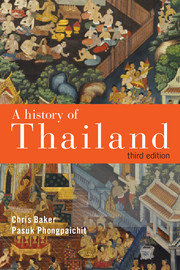Book contents
- Frontmatter
- Contents
- Illustrations
- Preface
- Abbreviations
- Glossary
- Chronology
- 1 Before Bangkok
- 2 The old order in transition, 1760s to 1860s
- 3 Reforms, 1850s to 1910s
- 4 Peasants, merchants, and officials, 1870s to 1930s
- 5 Nationalisms, 1910s to 1940s
- 6 The American era and development, 1940s to 1960s
- 7 Ideologies, 1940s to 1970s
- 8 Globalization and mass society, 1970s onwards
- 9 A political society, 1970s onwards
- Postscript: The strong state and the well-being of the people
- Notes
- Reigns and prime ministers
- Glossary of names
- Readings
- Index
4 - Peasants, merchants, and officials, 1870s to 1930s
Published online by Cambridge University Press: 05 August 2014
- Frontmatter
- Contents
- Illustrations
- Preface
- Abbreviations
- Glossary
- Chronology
- 1 Before Bangkok
- 2 The old order in transition, 1760s to 1860s
- 3 Reforms, 1850s to 1910s
- 4 Peasants, merchants, and officials, 1870s to 1930s
- 5 Nationalisms, 1910s to 1940s
- 6 The American era and development, 1940s to 1960s
- 7 Ideologies, 1940s to 1970s
- 8 Globalization and mass society, 1970s onwards
- 9 A political society, 1970s onwards
- Postscript: The strong state and the well-being of the people
- Notes
- Reigns and prime ministers
- Glossary of names
- Readings
- Index
Summary
The nation-state was new. So too were its citizens, as a result of two sweeping social changes. Beginning in the early 19th century, the landscape and society of the lower Chao Phraya basin was transformed by a frontier movement of peasant colonization. Uniquely in Asia, new land was being opened up faster than population growth from the mid-19th century right through to the 1970s. As a result of political decisions in the late 19th century, this frontier society was characterized not by landlords but by peasant smallholders. Until urbanization accelerated in the last quarter of the 20th century, this smallholder peasant society represented four-fifths of the population and was the main driving force of the economy.
Much of the urban population was also new, especially in the capital city of Bangkok. Continuous immigration from southern China made Chinese a dominant element in the city’s economic life. Western merchants and advisers formed a new semicolonial segment of the elite. A fledgling commoner middle class began to form around the city’s new role as capital of a nation-state.
TRANSFORMING THE RURAL LANDSCAPE AND SOCIETY
Europeans who visited Siam in the 1820s thought much of the Chao Phraya delta was a ‘wilderness’. Plains of scrub forest inhabited by wild elephants merged near the coasts and rivers into marshes dense with reeds and teeming with crocodiles. Settlements clung to the banks of the main rivers. Even along the Chao Phraya River from its estuary past Bangkok and into the upper delta, most of these banks looked ‘deserted’ and densely wooded (Figure 6). In the Ayutthaya era, the only extensive tract of rice cultivation had been the narrow corridor of floodplain running south from Chainat in the centre of the delta. Here farmers grew floating rice on the annual monsoon flooding.
- Type
- Chapter
- Information
- A History of Thailand , pp. 80 - 103Publisher: Cambridge University PressPrint publication year: 2014



